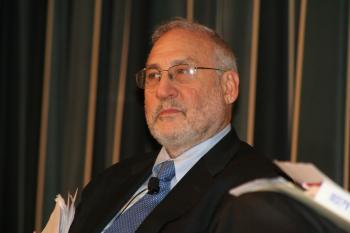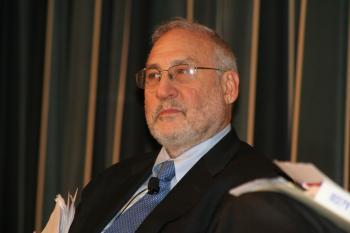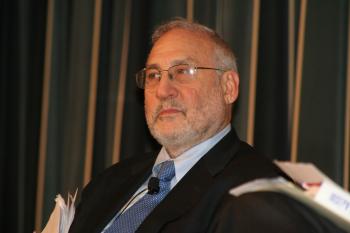WASHINGTON—The economic crisis of 2008 was predictable and economists could have seen it coming, according to economist Joseph Stiglitz.
The “Great Recession” was deeper and more serious than any previous crises since the Great Depression, but not really different in kind. Stiglitz is confident that he knows the source of the “sickness” of our economy and what needs to be done to make it well.
The 2001 Nobel Prize winner in economics gives his understanding of the origins of the crisis in a new book Freefall: America, Free Markets, and the Sinking of the World Economy.
Stiglitz, professor at Columbia University, has been explaining the basics discussed in Freefall recently to large audiences in Washington.
What triggered crisis
For few years during the Clinton administration, Stiglitz was chairman of the Council of Economic Advisers. From 1997-2000, he was chief economist at the World Bank. Even with his impressive resume, people would probably not be flocking in such great numbers to hear this best-selling author, were he not taking on the question that the public is clamoring to know the answer, “How did the largest economy in the world go into a freefall? What policies and what events triggered the great downturn of 2008?”
Without understanding how we got into this situation, we can’t correct what is wrong and ensure that it doesn’t happen again, according to Stiglitz.
The cause lies mostly with our financial markets and institutions that were rationalized by economic theories, which have been proven wrong, according to Stiglitz. Here is where Stiglitz parts company with the prevailing ideology on the role of free markets. Before the severe downturn in 2008, it was widely believed—and still is for Wall Street financiers—that free markets were efficient and if something goes wrong, the market would “self-correct.”
“Markets on their own evidently fail—and fail very frequently,” counters Stiglitz in Freefall.
Stiglitz loves to use Alan Greenspan, former chair of the Federal Reserve, as someone who did not approve of regulating the economy, not even to protect the public interest against fraud. In this view, the role of the central banks is mainly keeping interest rates low. Stiglitz is quick to point out that it is not on personalities, such as Greenspan, that he lays the blame, but on “fundamental flaws in the system.” He says that if Greenspan hadn’t been appointed Federal Reserve chairman by President Ronald Reagan, then “he would have found someone who did not favor regulation.”
Stiglitz puts forth the dictum that when markets are left alone, relying on self-interest of market participants, they don’t bring on optimum efficiency nor guarantee prosperity.
“Economies need a balance between the role of markets and the role of government…In the last 25 years, America lost that balance, and it pushed its unbalanced perspective on countries around the world,” Stiglitz says. He likes to remind us that government has repeatedly saved markets from themselves, and lists an almost endless number of countries where bailouts for questionable lending practices were necessary to restore an economy’s health.
Lesson forgotten
The value of government regulation in keeping the economy running smooth was the lesson from the Great Depression, which “we have forgot,” he claims. For a 50 years after World War II, we had only two or three economic crises, according to Stiglitz, because the regulatory structure created in the 1930s brought “growth and stability.” Since 1980—the beginning of the era of deregulation—we’ve had over 125 crises around the world. The one of 2008 was just the most severe and costly.






